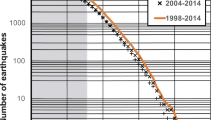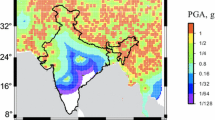Abstract
We apply the general concept of seismic risk analysis based on morphostructural analysis of the territory, pattern recognition of earthquake-prone nodes, and the Unified Scaling Law for Earthquakes, USLE, in another seismic region of Russia to the west from Lake Baikal, i.e., Altai–Sayan Region. The USLE generalizes the empirical Gutenberg–Richter relationship making use of apparently fractal distribution of earthquake sources of different size: \( \log_{10} N\left( {M,L} \right)\, = \,A\, + \,B \cdot \left( {5\, - \,M} \right)\, + \,C \cdot \log_{10} L, \) where N (M, L) is the expected annual number of earthquakes of a certain magnitude M within an seismically prone area of linear dimension L. The local estimates of A, B, and C allow determination of the expected maximum credible magnitude in a given time interval and the associated spread around ground shaking parameters (e.g., peak ground acceleration, PGA, or macroseismic intensity, I0). Compilation of the corresponding seismic hazard map of Altai–Sayan Region and its rigorous testing against the available seismic evidences in the past is used to model regional maps of specific earthquake risks for population, cities, and infrastructures.









(Reproduced with permission from Giardini et al. 1999)


Similar content being viewed by others
References
Castaños H, Lomnitz C (2002) PSHA: is it science? Eng Geol 66(3–4):315–317. https://doi.org/10.1016/S0013-7952(02)00039-X
Cornell CA (1968) Engineering seismic risk analysis. Bull Seismol Soc Am 58:1583–1606
Federal State Statistics Service (2016) The population of the Russian Federation for municipalities on January 1, 2016. FSSS: Moscow, Russian Federation. http://www.gks.ru/free_doc/doc_2016/bul_dr/mun_obr2016.rar. Assessed 19 Sept 2016
Gelfand IM, Guberman ShA, Izvekova ML, Keilis-Borok VI, Rantzman EYa (1972) On criteria of high seismicity. Trans (Doklady) Acad Sci SSSR 202:1317–1320
Gelfand IM, Guberman ShA, Keilis-Borok VI, Knopoff L, Press F, Ranzman EYa, Rotwain IM, Sadovsky AM (1976) Pattern recognition applied to earthquake epicenters in California. Phys Earth Planet Int 11:227–283
Geller RJ (2011) Shake-up time for Japanese seismology. Nature 472:407–409. https://doi.org/10.1038/nature10105
Gerasimov IP, Ranzman EYa (1973) Morphostructure of orogens and their seismicity. Geomorphology 1:3–13 (in Russian)
Giardini D, Grünthal G, Shedlock K, Zhang P (1999) The GSHAP global seismic hazard map. Ann Geofis 42(6):1225–1228
Giardini D, Grünthal G, Shedlock K, Zhang P (2003) The GSHAP global seismic hazard map. In: Lee WHK, Kanamori H, Jennings P, Kisslinger C (eds) International handbook of earthquake and engineering seismology, international geophysics series 81 B. Academic Press, Amsterdam, pp 1233–1239
Gorshkov A, Kossobokov V, Soloviev A (2003) Chapter 6. Recognition of earthquake-prone areas. In: Keilis-Borok VI, Soloviev AA (eds) Nonlinear dynamics of the lithosphere and earthquake prediction. Springer, Heidelberg, pp 239–310
Gorshkov AI, Soloviev AA, Zharkikh YuI (2018) Recognition of places of possible occurrence of strong earthquakes in the Altai–Sayan–Baikal region. Dokl Earth Sci 479(1):412–414. https://doi.org/10.1134/S1028334X1803025X
Gridded Population of the World, Version 3 (GPWv3) (2005) Palisades, NY: Socioeconomic Data and Applications Center (SEDAC), Columbia University, http://sedac.ciesin.columbia.edu/gpw. Accessed 05 July 2016
Gvishiani AD, Gorshkov AI, Kossobokov VG, Rantsman EYa (1986) Morphostructures and places of earthquaakes in the Greater Cousasus. Izvestia Acad Sci USSR Phys Earth 9:24–35 (in Russian)
Instruction on the order of production and processing of observations at seismic stations of the Unified System of Seismic Observations of the USSR (1982). Moscow, Nauka, p 273 (in Russian)
Keilis-Borok VI (1990) The lithosphere of the Earth as a nonlinear system with implications for earthquake prediction. Rev Geophys 28:19–34
Klügel JU (2007) Error inflation in probabilistic seismic hazard analysis. Eng Geol 90:186–192
Kondorskaya NV, Shebalin NV, Khrometskaya YaA, Gvishiani AD (1982) New catalog of strong earthquakes in the U.S.S.R. from ancient times through 1977. World data center a for solid earth geophysics, report SE-31, p 609
Kossobokov VG, Mazhkenov SA (1994) On similarity in the spatial distribution of seismicity. In: Chowdhury DK (ed) Computational seismology and geodynamics, vol 1. AGU, The Union, Washington DC, pp 6–15
Kossobokov V, Nekrasova A (2010) Global seismic hazard assessment program maps are misleading. Eos Trans AGU 91(52), Fall Meet Suppl, Abstract U13A-0020
Kossobokov V, Nekrasova A (2012) Global seismic hazard assessment program maps are erroneous. Seism Instrum 48(2):162–170. https://doi.org/10.3103/S0747923912020065
Kossobokov V, Peresan A, Panza GF (2015) Reality check: seismic hazard models you can trust. EOS 96(13):9–11
Malovichko AA (ed) (2015) The earthquakes of Russia in 2013. GS RAS, Obninsk, p 224 (inc. CD-ROM)
Malovichko AA (ed) (2017) The earthquakes of Russia in 2015. GS RAS, Obninsk, p 212 (inc. CD-ROM)
Nekrasova AK, Kosobokov VG (2005) Temporal variations in the parameters of the Unified Scaling Law for Earthquakes in the eastern part of Honshu Island (Japan). Dokl Earth Sci 405:1352–1356
Nekrasova AK, Kosobokov VG (2006) Unified scaling law for earthquakes in the Lake Baikal region. Dokl Earth Sci 407A(3):484–485
Nekrasova AK, Kosobokov VG (2016) Unified scaling law for earthquakes in crimea and Northern Caucasus. Dokl Earth Sci 470(2):1056–1058
Nekrasova A, Kossobokov V (2002) Generalizing the Gutenberg–Richter scaling law. EOS Trans AGU 83(47), NG62B–0958
Nekrasova A, Kossobokov V, Perezan A, Aoudia A, Panza GF (2011) A multiscale application of the unified scaling law for earthquakes in the central mediterranean area and Alpine region. Pure appl Geophys 168:297–327. https://doi.org/10.1007/s00024-010-0163-4
Nekrasova A, Peresan A, Kossobokov VG, Panza GF (2014) Chapter 7: a new probabilistic shift away from seismic hazard reality in Italy? In: Aneva B, Kouteva-Guentcheva M (eds) Nonlinear mathematical physics and natural hazards, Springer Proceedings in Physics, vol 163, pp 83–103. http://dx.doi.org/10.1007/978-3-319-14328-6_7
Nekrasova A, Kossobokov V, Parvez IA, Tao X (2015) Seismic hazard and risk assessment based on the unified scaling law for earthquakes. Acta Geod Geophys 50(1):21–37. https://doi.org/10.1007/s40328-014-0082-4
Panza GF, Romanelli F, Vaccari F (2001) Seismic wave propagation in laterally heterogeneous anelastic media: theory and applications to seismic zonation. Adv Geophys 43:1–95
Panza G, Irikura K, Kouteva-Guentcheva M, Peresan A, Wang Z, Saragoni R (eds) (2011) Advanced seismic hazard assessment. Pure Appl Geophys, vol 168 (1–4), p 752
Panza GF, La Mura C, Peresan A, Romanelli F, Vaccari F (2012) Seismic hazard scenarios as preventive tools for a disaster resilient society. In: Dmowska R (ed) Advances in geophysics. Elsevier, London, pp 93–165
Panza GF, Kossobokov V, Peresan A, Nekrasova A (2014) Chapter 12. Why are the standard probabilistic methods of estimating seismic hazard and risks too often wrong? In: Wyss M, Shroder J (eds) Earthquake hazard, risk, and disasters. Elsevier, London, pp 309–357
Parvez IA, Gusev A, Panza GF, Petukhin A (2001) Preliminary determination of the interdependence among strong motion amplitude, earthquake magnitude and hypocentral distance for the Himalayan region. Geophys J Int 144:577–596
Parvez IA, Vaccari F, Panza GF (2003) A deterministic seismic hazard map of India and adjacent areas. Geophys J Int 155:489–508
Parvez IA, Nekrasova A, Kossobokov V (2014) Estimation of seismic hazard and risks for the Himalayas and surrounding regions based on unified scaling law for earthquakes. Nat Hazards 71(1):549–562. https://doi.org/10.1007/s11069-013-0926-1
Parvez IA, Nekrasova A, Kossobokov V (2017) Earthquake hazard and risk assessment based on unified scaling law for earthquakes: state of Gujarat, India. Pure Appl Geophys 174(3):1441–1452. https://doi.org/10.1007/s00024-017-1475-4
Peresan A, Zuccolo E, Vaccari F, Gorshkov A, Panza GF (2011) Neo-deterministic seismic hazard and pattern recognition techniques: time-dependent scenarios for North-Eastern Italy. Pure appl Geophys 168(3):583–607. https://doi.org/10.1007/s00024-010-0166-1
Peresan A, Magrin A, Nekrasova A, Kossobokov VG, Panza GF (2013) Earthquake recurrence and seismic hazard assessment: a comparative analysis over the Italian territory. In: Proceedings of the ERES 2013 conference. WIT Transactions on the Built Environment, vol 132, pp 23–34. http://dx.doi.org/10.2495/ERES130031
Rautian TG (1960) Energy of earthquakes. In: Methods of detailed study of seismicity. Moscow: Publishing house of the Institute of Physics of the Academy of Sciences of the USSR, pp 75–114. (Trudy IFZ AN SSSR, No. 9 (176))
Soloviev AA, Gvishiani AD, Gorshkov AI, Dobrovolsky MN, Novikova OV (2014) Recognition of earthquake prone areas: methodology and analysis of the results. Izv Phys Solid Earth 50(2):151–168
Starovoit OE (ed) (2015) The earthquakes of Northern Eurasia, 2009. FSIS GS RAS, Obninsk, p 394 (inc. CD-ROM)
Wang ZM (2011) Seismic hazard assessment: issues and alternatives. Pure appl Geophys 168(1–2):11–25. https://doi.org/10.1007/s00024-010-0148-3
Wyss M (2015) Chapter 20: do probabilistic seismic hazard maps address the need of the population? In: Wyss M, Peppoloni S (eds) Geoethics: ethical challenges and case studies in earth sciences. Elsevier, New York, pp 239–249. https://doi.org/10.1016/B978-0-12-799935-7.00020-4
Wyss M, Nekrasova A, Kossobokov V (2012) Errors in expected human losses due to incorrect seismic hazard estimates. Nat Hazards 62(3):927–935. https://doi.org/10.1007/s11069-012-0125-5
Acknowledgements
The study was supported by the Russian Science Foundation Grant No. 15-17-30020.
Author information
Authors and Affiliations
Corresponding author
Rights and permissions
About this article
Cite this article
Kossobokov, V.G., Nekrasova, A.K. Earthquake hazard and risk assessment based on unified scaling law for earthquakes: Altai–Sayan Region. Nat Hazards 93, 1435–1449 (2018). https://doi.org/10.1007/s11069-018-3359-z
Received:
Accepted:
Published:
Issue Date:
DOI: https://doi.org/10.1007/s11069-018-3359-z




